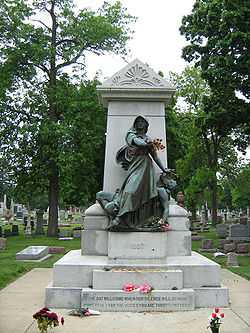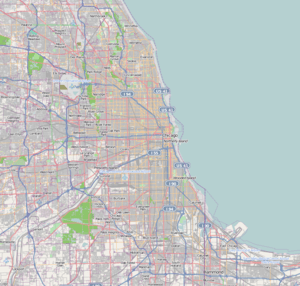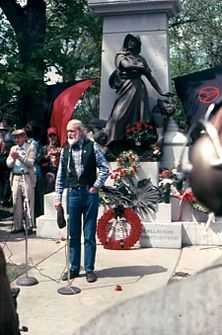Haymarket Martyrs' Monument
|
Haymarket Martyrs' Monument | |
 | |
 | |
| Location | The Forest Home Cemetery, Forest Park, Illinois. |
|---|---|
| Coordinates | 41°52′11″N 87°49′11″W / 41.86972°N 87.81972°WCoordinates: 41°52′11″N 87°49′11″W / 41.86972°N 87.81972°W |
| Area | less than one acre |
| Built | dedicated June 25, 1893 |
| Sculptor | Albert Weinert[1] |
| Governing body | Private |
| NRHP Reference # | 97000343[2] |
| Significant dates | |
| Added to NRHP | April 26, 2002[2] |
| Designated NHL | February 18, 1997 |
The Haymarket Martyrs' Monument is a funeral monument located at Forest Home Cemetery in Forest Park, Illinois, a suburb of Chicago. Dedicated in 1893, it commemorates the defendants involved in the labor unrest and bombing related to the Haymarket Affair (1886). On February 18, 1997 it was designated a National Historic Landmark, and on April 26, 2002 listed on the National Register of Historic Places by the United States Department of the Interior.
History
Following the Haymarket affair, and trial and executions, August Spies, Samuel Fielden, Adolph Fischer, George Engel, Louis Lingg, and Albert Parsons were buried at the German Waldheim Cemetery (later merged with Forest Home Cemetery).
The Pioneer Aid and Support Association organized a subscription for a funeral monument. In 1893, the Haymarket Martyrs' Monument by sculptor Albert Weinert was raised at Waldheim. It consists of a 16-foot-high granite shaft capped by a carved triangular stone. There is a two step base, which also supports a monumental figure of a woman standing over the body of a fallen worker, both in bronze. It was dedicated on June 25, 1893, after a march from Chicago. The inscription on the steps read, "1887," the year of the executions. Also, there is a quote attributed to Spies, recorded just before his execution by hanging: "The day will come when our silence will be more powerful than the voice you are throttling today." On the back of the monument are listed the names of the men. On the top of the monument, a bronze plaque contains text of the pardon later issued by Illinois governor John Peter Altgeld[2]
The dedication ceremony was attended by 8000, with union flags and the American flag draped on the monument. European unions and American organizations sent flowers to be placed.[2] Many activists and labor leaders were subsequently buried nearby. Michael Schwab and Oscar Neebe were also buried at Waldheim when they died, reuniting the "Martyrs." For years, annual commemorations were held.
Gallery
-

Utah Phillips speaking at Waldheim Cemetery, Forest Park (outside Chicago) in May 1986 during ceremonies commemorating the 100th anniversary of the Haymarket affair.
-

Rear of Haymarket Martyrs Monument.
-
Marker on Haymarket Martyrs Monument added in 1997.
References
- ↑ "Haymarket Martyrs' Monument, (sculpture)." SIRIS
- ↑ 2.0 2.1 2.2 2.3 National Historic Landmark Nomination form, 1997 , Robin Bachin, Newberry Library.
